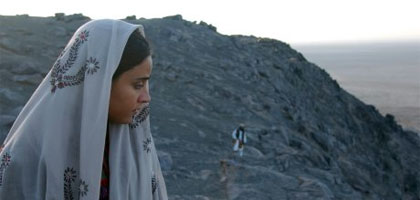
A Silence between Two Thoughts
Iran/Switzerland 2003

Reviewed by John Wrathall
Synopsis
Our synopses give away the plot in full, including surprise twists.
Eastern Iran, the present. A young man who works as an executioner for the Hajji, the spiritual leader of a remote village, is ordered to spare his latest victim on the grounds that she is a virgin, and would go straight to heaven if killed. When he is ordered to marry the virgin, the executioner questions the Hajji's leadership for the first time.
The executioner is ostracised by the villagers, including his adopted family, for his role in the Hajji's reign of terror. The Moazen, who was responsible for his religious education, tells him he has been seduced by Satan. Under the guidance of a venerable matriarch known as Auntie, the women of the community prepare for a pilgrimage. The Hajji wants to ban it, but the Moazen insists it should go ahead. On the pilgrimage, Auntie gives the virgin seven grains of wheat, and tells her to make a wish. Auntie dies. The virgin takes the opportunity to escape, but stops when confronted by the vastness of the surrounding desert. The executioner recaptures her and locks her up. Turning away from violence, he buries his gun.
Hearing that the Hajji has killed the Moazen, the executioner releases the virgin. The villagers rise up against the Hajji's followers, and seize the executioner. As the Virgin walks free, she hears shots as the executioner is killed.
Review
Judging from the plot summary above, Silence between Two Thoughts might sound more conventionally dramatic than much of the recent Iranian cinema seen in the west. But in fact the film sets a new benchmark for austerity, even by Iranian standards. It opens with an extraordinary nine-minute take: in the grey light of dawn, a man sits waiting, his face masked by a scarf. After a while he stands up, raises his rifle and fires a shot. We don't see what he is shooting at, but his air is so impassive, it could be target practice. He sits down again, then stands and fires a second shot. He wipes something from his eye, perhaps a tear. He is about to shoot a third time when he receives the order to stop. He sits down and drinks a cup of tea, talking to the boy who sold it to him. The camera starts to circle him. A cart passes in the background, carrying away the corpses of his first two victims. Very slowly, the camera keeps circling, until it's behind the executioner and we can see what he sees: the figure of a woman, standing in front of a wall – the third victim, whom he has been ordered to spare on the grounds that she is a virgin, and would therefore go straight to heaven if killed. Two women walk into frame and lead the virgin away. The executioner gets up, shoulders his rifle and goes over to the wall, where he picks up the woman's discarded cloak and sandals, before walking out of shot.
The shooting style – long takes, the occasional measured tracking shot – may recall that of Abbas Kiarostami, along with Mohsen Makhmalbaf, one of the godfathers of modern Iranian cinema (the film was co-edited by Jafar Panahi, director of the Kiarostami-scripted The White Balloon, 1995, one of the first Iranian films to break through in the west). But whereas for Kiarostami the camera's very restraint provides the breathing space in which flickers of unexpected life may be captured – the sudden grins of children, the background bustle of city life – in this third film by writer-director Babak Payami, the austerity of the visual style is matched by a corresponding austerity in all other departments, with not a trace of the sly comedy of his previous film, Secret Ballot.
The title Silence between Two Thoughts refers to the crisis of doubt undergone by the protagonist, the executioner, as he comes to question his spiritual leader, the Hajji, in whose name he has shed so much blood. But none of this shows in his face, as played with Bressonian impassiveness by Kamalan Narouii, a charismatic non-professional recruited by the director in the remote village on the eastern border of Iran where the film was shot. The solemnity of the actors is matched by the barren landscape: parched earth, rock and glaring white skies. All dramatic events, from the opening executions to the death of the Moazen, occur off camera. Sometimes this obliqueness works to powerful effect, as at the film's climax: when the villagers put the executioner up against the wall and debate whether to kill him, the camera stays fixed on his face, until he is suddenly dragged out of shot. At other times, it is just mystifying: while the opening scene of the film sets up the paradox that the executioner is ordered to marry the victim he has spared, the implication being that he can thus deflower and then execute her, by the end of the film it is unclear (at least to this reviewer) whether the marriage has taken place.
This obliqueness may not always have been intentional on the part of Payami: the negative of his film was confiscated by the Iranian authorities, and this print appears to have been assembled using a video copy to plug the gaps. (Despite that misfortune, one of the film's most haunting features is Farzad Jodat's cinematography, which starkly captures the grey light of the desert at sunset.) With its remorseless depiction of a barren, blighted land, where traditions are dying but the only sign of the 21st century are the binoculars with which the Hajji spies on the villagers, this is hardly a vision of Iran that the country's rulers would want to export.
Credits
- Director
- Babak Payami
- Producer
- Babak Payami
- Screenplay
- Babak Payami
- Director of Photography
- Farzad Jodat
- Editors
- Jafar Panahi
- Babak Karimi
- Art Directors
- Farzad Jodat
- Babak Payami
